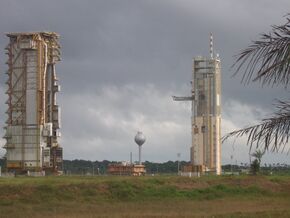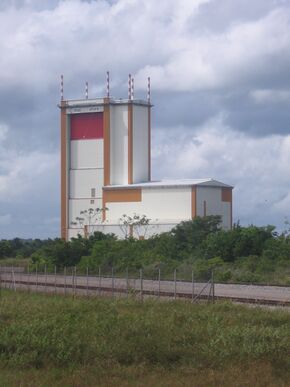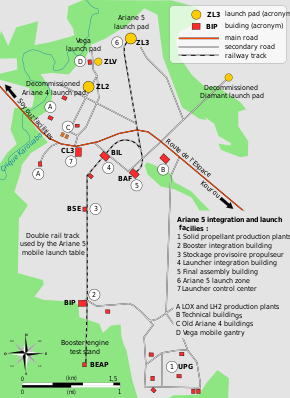المركز الفضائي بگويانا
5°13′20″N 52°46′25″W / 5.22222°N 52.77361°W
| ملف:Guiana Space Centre logo.svg | |
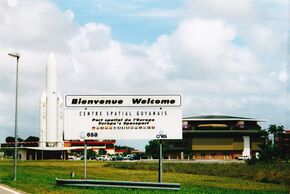 Sign at the entrance to the Guiana Space Centre | |
| وكالة استعراض | |
|---|---|
| تشكلت | 14 أبريل 1964 |
| الاختصاص | Government of France |
| المقر الرئيسي | Kourou, French Guiana, France |
| الموظفون | 1,525 direct (2011) 7,500 indirect (2011) |
| تنفيذي الوكالة |
|
| الوكالة الأم | ESA/CNES |
| الموقع الإلكتروني | www |
| الخريطة | |
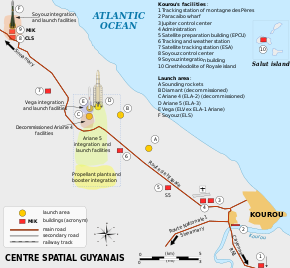 Map of Guiana Space Centre | |
المركز الفضائي بگويانا (فرنسية: Centre Spatial Guyanais؛ CSG؛ إنگليزية: Guiana Space Centre) هو ميناء فضائي فرنسي وأوروپي إلى الشمال الغربي من كورو في گويانا الفرنسية، المنطقة الفرنسية في أمريكا الجنوبية. وهو يعمل منذ 1968، وهو مناسب بشكل خاص كموقع لميناء فضائي، إذ يفي بمتطلَبين جغرافيين رئيسيين لمثل هذا الموقع:
- القرب من خط الإستواء، so that less energy is required to manoeuvre a spacecraft into an equatorial, geostationary orbit. Rockets launch to the east to take advantage of the angular momentum provided by Earth's rotation.
- It has open sea to the east, so that lower stages of rockets and debris from launch failures are unlikely to fall on human habitations.
The European Space Agency (ESA), the French space agency CNES (National Centre for Space Studies), and the commercial companies Arianespace and Azercosmos conduct launches from Kourou.[1][2][3] This was the spaceport used by the ESA to send supplies to the International Space Station using the Automated Transfer Vehicle.
التاريخ
The location was selected in 1964 to become the spaceport of France.[4][5]
In 1975, France offered to share Kourou with ESA.[4][5] Commercial launches are bought also by non-European companies. ESA pays two thirds of the spaceport's annual budget and has also financed the upgrades made during the development of the Ariane launchers.
On 4 April 2017, the centre was occupied by 30 labour union leaders in the midst of the 2017 social unrest in French Guiana, but was taken back on 24 April 2017.[6]
المنشآت
Kourou is located approximately 500 km (310 mi) north of the equator, at a latitude of 5°. It is a common misconception[بحاجة لمصدر] that the main advantage of launching a rocket from the equator is the extra boost provided by the speed of the Earth's rotation. For example, the eastward boost provided by the Earth's rotation is about 463 m/s (1،520 ft/s) at the Guiana Space Centre, as compared to about 406 m/s (1،330 ft/s) at the United States east coast Cape Canaveral and Kennedy Space Center spaceports which are at 28°27′N latitude in Florida. This means that rockets need around 60 m/s more delta-v to reach Low Earth Orbit (LEO) from Cape Canaveral, which is an insignificant disadvantage.[7][8]
In reality, the main benefit of Kourou is that the near-equatorial launch location provides an advantage for launches to low-inclination (or geostationary) Earth orbits compared to launches from spaceports at higher latitude. This is because rockets can be launched into orbits with an inclination of as low as ~6°. The lowest inclination a rocket from Cape Canaveral could be launched to is 28.5° (the latitude of Cape Canaveral). Inclination change burns already require significant amounts of delta-v, so needing to change inclination by 28.5° seriously affects a rocket's capability to send satellites into a geostationary transfer orbit (GTO). As a result of these phenomena, similarly sized Proton and Ariane 5 rockets can send similar payloads to LEO. However, the Proton, launched from high latitudes in Russia, can only send 6,270 kg to GTO while a Kourou-launched Ariane 5 can send more than 10,000 kg to GTO.[9][10] However, the massive SpaceX Falcon Heavy makes up for the geographic disadvantage of Cape Canaveral by lifting up to 26,700 kg to GTO.[11]
BEC / ELA-1 / ELV
Originally built in the 1960s under the name of Base Équatoriale du CECLES (BEC) (فرنسية: Conférence Européenne de Construction de Lanceurs et d'Engins Spatiaux, إنگليزية: European conference on construction of launchers and spacecraft), the pad located at 5°14′10″N 52°46′30″W / 5.236°N 52.775°W was designed for the Europa-II launch vehicle. One Europa-II was launched from the site, before the programme was cancelled.[بحاجة لمصدر]
The pad was demolished, and subsequently rebuilt as the first launch complex for Ariane rockets. Renamed ELA (later redesignated ELA-1) (فرنسية: Ensemble de Lancement Ariane-1), it was used for Ariane 1 and Ariane 2 and 3 launches until being retired in 1989.[12]
In November 2001, it was renamed ELV pad (فرنسية: Ensemble de Lancement Vega) and refurbished again for the Vega rocket. The first launch was performed on 13 February 2012.[13]
ELA-2
The ELA-2 pad (فرنسية: Ensemble de Lancement Ariane-2), located at 5°13′55″N 52°46′34″W / 5.232°N 52.776°W had been used for Ariane 4 launches until 2003.[بحاجة لمصدر]
ELA-3
ELA-3 (فرنسية: Ensemble de Lancement Ariane-3) has been active for Ariane 5 launches since 1996 (Ariane 501). This facility is located at 5°14′20″N 52°46′05″W / 5.239°N 52.768°W and covers an area of 21 km2 (8.1 sq mi).[14]
ELA-4
ELA-4 (فرنسية: Ensemble de Lancement Ariane-4) is presently under construction, intended for future Ariane 6 launches. This facility is located at 5°15′45″N 52°47′27″W / 5.26258°N 52.79074°W.[15]
ELS / Soyuz في CSG
ESA has built ELS (فرنسية: Ensemble de Lancement Soyouz) at 5°18′18″N 52°50′02″W / 5.305°N 52.834°W for launching Russian-built Soyuz-2 rockets. The first Soyuz launch from ELS was postponed several times, but launched on 21 October 2011.[16]
ELS is located on the territory of Sinnamary commune, 27 km (17 mi) from Kourou harbor.[17] It is 10 km (6.2 mi) northwest of the site used for the Ariane 5 launches. Under the terms of the Russo-European joint venture, ESA will augment its own launch vehicle fleet with Soyuz rockets — using them to launch ESA or commercial payloads — and the Russians will get access to the Kourou spaceport for launching their own payloads with Soyuz rockets. Russia will use the Guiana Space Centre in addition to Baikonur Cosmodrome. The Guiana location has the significant benefit of greatly increased payload capability, owing to the near equatorial position. A Soyuz rocket with a 1.7 tonnes to geostationary transfer orbit (GTO) performance from Baikonur, will increase its payload potential to 2.8 tonnes from the Guiana launch site.[18]
The ELS project is being co-funded by Arianespace, ESA, and the European Union, with CNES being the prime contractor. The project has a projected cost of approximately €320 million, where €120 million are allocated for modernizing the Soyuz vehicle.[19] The official opening of the launch site construction occurred on 27 February 2007. Excavation work however, had previously begun several months beforehand.
On 13 September 2010, Spaceflight Now reported that after several delays in the construction of a mobile gantry the launch pad had been finished, and the first flight of the Soyuz was expected to occur in early 2011.[20] By October 2010, 18 launch contracts had been signed. Arianespace has ordered 24 launchers from Russian industry.[21]
On 21 October 2011, two Galileo IOV-1 and IOV-2 satellites were launched using a Soyuz-ST rocket, in the "first Russian Soyuz vehicle ever launched from Europe's Spaceport in French Guiana."[22]
مبنى التجميع النهائي
Astrium assembles each Ariane 5 launcher in the Launcher Integration Building. The vehicle is then delivered to the Final Assembly Building for payload integration by Arianespace.[23] The Final Assembly Building is located 2.8 km (1.7 mi) from the ELA-3 launch zone. The mobile launch table completes the trip with an Ariane 5 in about one hour. It is then secured in place over the launch pad's flame ducts.[24]
عمليات الإطلاق
أمان الإطلاق
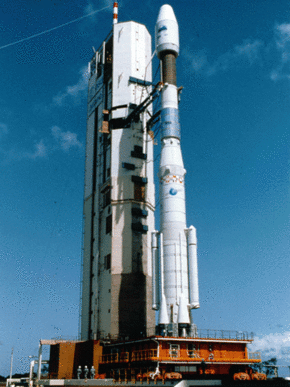
Fire safety is ensured by a detachment of the Paris Fire Brigade, a branch of the French Army. Security around the base is ensured by French Gendarmerie forces, assisted by the 3rd Foreign Infantry Regiment of the French Foreign Legion.[بحاجة لمصدر] Before and during launch windows, CSG facility security is significantly enhanced by anti-personnel and anti-aircraft measures, the exact configurations of which are classified by the French military. All entrants to the launch complex are also subject to checks for proof of permission to enter the facility.[بحاجة لمصدر]
The Guiana Space Centre (as per CNES) also contains the Îles du Salut, a former penal colony including the infamous Devil's Island. Now a tourist site, the islands are under the launching trajectory for geosynchronous orbit and have to be evacuated during launches.
Early launches
- 10 March 1970 - The first Diamant-B launched the DIAL/MIKA and DIAL/WIKA satellites. DIAL/MIKA failed during launch, but it entered orbit with a total mass of 111 kg.[25] DIAL/WIKA provided data for about two months after launch.[26]
عمليات الإطلاق الأخيرة
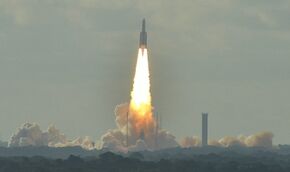
- 5 October 2007 — An Ariane 5 GS launched from CSG carrying Intelsat 11 and Optus D2.[27]
- 9 March 2008 — An Ariane 5 launched carrying the ATV (Automated Transfer Vehicle) Jules Verne in preparation for docking with the International Space Station (ISS). This was the first launch of the ESA unmanned resupply craft.
- 14 August 2008 — An Ariane 5 carrying Superbird 7 for Mitsubishi Electric Corporation and AMC-21 for SES Americom
- 20 December 2008 — An Ariane 5 carrying HOT BIRD 9 and W2M for Eutelsat[29][30]
- 14 May 2009 — An Ariane 5 carrying the ESA's Herschel and Planck space telescopes[31]
- 1 July 2009 — An Ariane 5 carrying TerreStar-1, the heaviest commercial telecommunications satellite ever launched[32]
- 18 December 2009 — An Ariane 5 carrying Helios 2B European military observation satellite used by France, Belgium, Spain and Greece.[33]
- 21 May 2011 — 04:38 (GMT+08:00) An Ariane 5 ECA launch vehicle launched carrying ST-2 Satellite twice as powerful Singtel's first satellite ST-1 which was launched back in 1998. It will provide 20% more transponder capacity and a wider coverage footprint than ST-1, with C-band and Ku-band coverage of the Middle East, Central Asia, Indian subcontinent and Southeast Asia.[بحاجة لمصدر]
- 21 October 2011 — A Soyuz-2 carrying two Galileo satellites was launched. This was the first launch of a Soyuz rocket at the Centre Spatial Guyanais.[34]
- 17 December 2011 — A Soyuz carrying the French space agency's Pleiades 1 Earth imaging satellite, four ELISA electronic intelligence satellites, and the SSOT remote sensing satellite for the Chilean military. This was the second launch of a Soyuz at the Guiana Space Centre.[35]
- 13 February 2012 — The Vega, which was designed in Italy, lifted off at 10:00 UTC on its maiden voyage. The launcher released nine satellites into orbit: two Italian satellites and seven pico-satellites.[36]
- 5 July 2012 — The unmanned Ariane 5 rocket took off to send an American communication satellite and European weather-monitoring spacecraft into orbit. Liftoff occurred at 21:36 UTC.[37]
- 30 August 2013 — Indian Space Research Organisation (ISRO) launched the advanced multi-band communication satellite GSAT-7.[38] It was 17th Indian satellite launched from ESA with Ariane 5.[39]
- 16 October 2014 — An Ariane 5 launch vehicle carrying the communication satellite ARSAT-1 to orbit. It is the first satellite built by an Latin American country (Argentina), and the second one of the Americas, after USA.
- 30 September 2015 — An Ariane 5 launch vehicle carrying the communication satellite ARSAT-2 to orbit, being the second Argentine satellite built in two years.
- 1 October 2015 — Sky Muster (NBN-Co 1A) is a communication satellite launched on an Ariane 5 ECA launch vehicle. Sky Muster is the first satellite of an operation to improve Australia's internet with the NBN program.
- 6 October 2016 — Sky Muster II (NBN-Co 1B) is a communication satellite launched on an Ariane 5 ECA launch vehicle. Sky Muster II is the second satellite of an operation to improve Australia's internet with the NBN program.
- 28 January 2017 — A Soyuz-2 STB carrying the geostationary communication satellite Hispasat 36W-1 to orbit. It is the first of the ESA's "Small-GEO" class of satellites.
- 14 February 2017 - An Ariane 5 launch vehicle carrying the commercial communication satellites Sky Brasil 1 (Intelsat 32e) and Telekom 3S launched the satellites to a geostationary orbit.
- 25 January 2018 - Partial failure of Ariane 5 launch vehicle on Ariane flight VA241.
- 19 October 2018 - An Ariane 5 launch vehicle launches the European-Japanese BepiColombo mission to Mercury.[40]
- 5 February 2019 - Ariane 5 launched the Saudi Geostationary Satellite SGS-1 (also known as SaudiGeosat-1/HellasSat-4).
- 11 July 2019 - Vega launch vehicle failed to launch Falcon Eye 1 satellite for United Arab Emirates Armed Forces.
الإطلاقات المستقبلية
- 31 October 2021 James Webb Space Telescope.[42][43]
Launch statistics
اعتبارا من 2017[تحديث], Kourou counts amongst the spaceports with the highest percentage of successful launches, both successive and overall. Here is a chronology of all orbital launches from the Kourou spaceport since 1970, under the French and European space programmes.
Flights by launcher
In development:
Ariane 6
Active:
Ariane 5
Soyuz ST
Vega
Retired:
Diamant
Europa 2
Ariane 1
Ariane 2
Ariane 3
Ariane 4
Flights by mission outcome
Success Failure Partial Failure Scheduled
Charts include all orbital launches from Kourou; sounding rockets are excluded.
Historical data: launch tables from List of Ariane launches, Soyuz ST, Vega and Encyclopedia Aeronautica.
Last updated on 28 November 2019.[44][45]
انظر أيضاً
- European Space Operations Centre (ESOC)
- European Space Research and Technology Centre (ESTEC)
- European Space Astronomy Centre (ESAC)
- European Astronaut Centre (EAC)
- European Centre for Space Applications and Telecommunications (ECSAT)
- ESA Centre for Earth Observation (ESRIN)
- European Space Tracking Network (ESTRACK)
- European Space Agency (ESA)
- 3rd Foreign Infantry Regiment
الهامش
- ^ "CNES at Europe's Spaceport". European Space Agency. ESA.
- ^ "ESA at Europe's Spaceport". European Space Agency. ESA.
- ^ "Arianespace at Europe's Spaceport". European Space Agency. ESA.
- ^ أ ب "Installation of the Guiana Space Center in French Guiana" Archived 1 مايو 2016 at the Wayback Machine. Guiana Space Centre official website
- ^ أ ب "Europe's Spaceport" Archived نوفمبر 26, 2012 at the Wayback Machine. European Space Agency official website
- ^ "Guyane : le Centre spatial guyanais occupé par des manifestants". La Croix. 5 أبريل 2017. Retrieved 5 أبريل 2017.
- ^ "Satellite Programmes Overview - Launching Satellites". EUMETSAT. Retrieved 30 ديسمبر 2010.
- ^ "Up, Up, and Away". The Universe: In the Classroom. Astro Society. Archived from the original on 8 أغسطس 2011. Retrieved 11 أغسطس 2011.
- ^ "Ariane 5 - Arianespace". Arianespace. Retrieved 23 أغسطس 2017.
- ^ "Commercial Launch Vehicle | ILS Proton Breeze M | International Launch Services". ilslaunch.com. Retrieved 23 أغسطس 2017.
- ^ "Vehicles: Falcon Heavy". SpaceX. Retrieved 16 ديسمبر 2020.
- ^ "Pad List - World Launch Sites". Space Launch Report. Archived from the original on 22 أكتوبر 2009.
- ^ "Vega liftoff / Vega / Launch vehicles / Launchers / Our Activities / ESA". esa.int. 13 فبراير 2012. Retrieved 12 سبتمبر 2013.
- ^ "Europe's spaceport". ESA.
- ^ "Construction update photographs". DutchSpace.
- ^ SpaceflightNow's VS01 flight status page Archived مايو 14, 2015 at the Wayback Machine
- ^ Harvey, Brian (10 أغسطس 2007). Space Exploration 2007. Springer Science & Business Media. p. 138. ISBN 978-0-387-48758-8.
- ^ (in فرنسية) Le Port Spatial de l'Europe (CNES) Archived سبتمبر 30, 2008 at the Wayback Machine
- ^ "Europe To Pay Russia To Build Soyuz Pad At Kourou: Russia". SpaceDaily.
- ^ "Soyuz, Vega flights from French Guiana set for 2011".
- ^ "Arianespace hosts meeting of launch system manufacturers" (Press release). Evry. 11 أكتوبر 2010.
- ^ Messier, Doug (22 أكتوبر 2011). "Soyuz Launches From Kourou for First Time". Parabolic Arc. Retrieved 24 أكتوبر 2011.
- ^ "Arianespace receives its fifth Ariane 5 of 2008". Arianespace. 28 يوليو 2008.[dead link]
- ^ "Ariane 5 rolls out for Arianespace's fifth launch of 2007". Arianespace. 8 نوفمبر 2007. Archived from the original on 25 يناير 2008.
- ^ "DIAL/MIKA - NSSDC ID: 1970-017B". NASA NSSDC.
 هذا المقال يضم نصاً من هذا المصدر، الذي هو مشاع.
هذا المقال يضم نصاً من هذا المصدر، الذي هو مشاع.
- ^ "DIAL/WIKA - NSSDC ID: 1970-017A". NASA NSSDC.
 هذا المقال يضم نصاً من هذا المصدر، الذي هو مشاع.
هذا المقال يضم نصاً من هذا المصدر، الذي هو مشاع.
- ^ "Arianespace boosts Intelsat 11 and Optus D2 into orbit". Arianespace. Archived from the original on 1 يونيو 2008.
- ^ "Vietnam successfully pilots Vinasat-1". VietNamNet. 22 أبريل 2011. Retrieved 14 أغسطس 2013.
- ^ http://www.eutelsat.com/satellites/HB9-W2M.html Archived يناير 22, 2009 at the Wayback Machine
- ^ "Eutelsat's Hot Bird 9 and W2M Satellites Lofted into Orbit" (PDF) (Press release). Paris: Eutelsat Communications. 20 ديسمبر 2008. Archived from the original (PDF) on 6 أبريل 2012.
- ^ "ESA en route to the origins of the Universe". ESA. 14 مايو 2009. Retrieved 14 مايو 2009.
- ^ Amos, Jonathan (1 يوليو 2009). "Ariane lofts biggest 'space bird'". BBC. Retrieved 2 يوليو 2009.
- ^ "Helios 2". Archived from the original on 31 أكتوبر 2012. Retrieved 19 ديسمبر 2012.
- ^ Rosenberg, Zach. "First Soyuz launch from French Guiana". FlightGlobal. Retrieved 11 أغسطس 2014.
- ^ "Arianespace VSO2 mission: Soyuz STA orbits Pleiades 1A, ELISA and SSOT". Arianespace. Retrieved 11 أغسطس 2014.
- ^ "Successful lift-off for Vega rocket". News24.
- ^ "Follow Ariane launch live". Centre National d'Études Spatiales. CNES.
- ^ India launches first defence satellite GSAT-7 Archived يناير 4, 2016 at the Wayback Machine
- ^ Navy's first satellite GSAT-7 now in the Space Archived نوفمبر 1, 2014 at archive.today The Hindu, August 30, 2013 by Madhumati D. S.
- ^ "BepiColombo Spacecraft Launch on 7-Year Trek to Mercury for Europe and Japan". space.com. Retrieved 20 أكتوبر 2018.
- ^ "Northrop Grumman's Second Mission Extension Vehicle and Galaxy 30 Satellite Begin Launch Preparations in French Guiana".
{{cite web}}: CS1 maint: url-status (link) - ^ "JWST factsheet". Archived from the original on 6 مايو 2016. Retrieved 7 سبتمبر 2013.
- ^ "NASA Completes Webb Telescope Review, Commits to Launch in Early 2021". 27 يونيو 2018. Archived from the original on 30 يونيو 2018. Retrieved 1 يوليو 2018.
- ^ Clark, Stephen (26 أكتوبر 2018). "Launch schedule". Spaceflight Now. Retrieved 28 أكتوبر 2018.
- ^ "Le Centre Spatial Guyanais - CNES". cnes-csg.fr.
وصلات خارجية
- Official website (in فرنسية)
- Soyouz in Guiana
- Europe's Spaceport – information from ESA
- List of Stratospheric Balloons launched from CSG – information from StratoCat
- Arianespace mission status – information on current and upcoming Ariane missions; list of past missions
- Pages using gadget WikiMiniAtlas
- Articles with فرنسية-language sources (fr)
- Articles with dead external links from October 2017
- Webarchive template archiveis links
- CS1 maint: url-status
- Coordinates on Wikidata
- Short description is different from Wikidata
- Use British English from October 2020
- Use dmy dates from October 2020
- Articles containing فرنسية-language text
- Pages using Lang-xx templates
- Articles containing إنگليزية-language text
- Articles with unsourced statements from May 2018
- Articles with hatnote templates targeting a nonexistent page
- Articles with unsourced statements from July 2012
- مقالات فيها عبارات متقادمة منذ 2017
- جميع المقالات التي فيها عبارات متقادمة
- Pages using div col with small parameter
- Official website different in Wikidata and Wikipedia
- المركز الفضائي بگويانا
- وكالة الفضاء الأوروپية
- موانئ فضائية
- مباني ومنشآت في گويانا الفضائية
- مواقع إطلاق صواريخ
- البرنامج الفضائي الفرنسي
- تأسيسات 1968 في أمريكا الجنوبية
- تأسيسات 1968 في فرنسا
